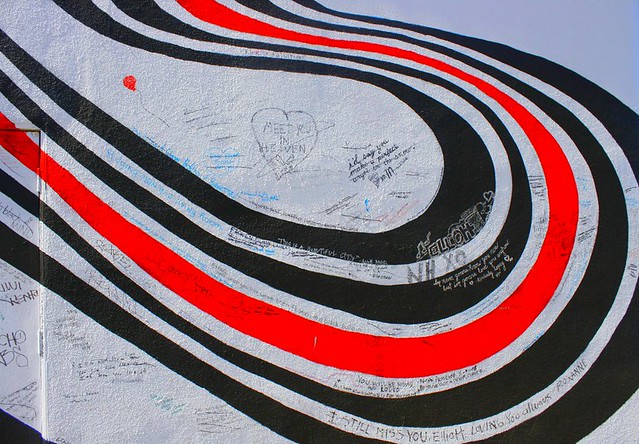When I lived alone
I sometimes had solitary painting parties on sporadic Saturday nights. I turned
off the cell phone to the outside world, bought a bottle of cheap red wine,
because I really did not know anything about wine back then, and shut myself
in. My only table covered in newspaper became the easel and I surrounded my
blank canvas with distressed brushes, and squeezed and contorted tubes of oil
paint. I grabbed a photograph out of a shoebox or an old album and it became my
spontaneous motif. The cork removed from the wine, to be poured into a white
coffee mug, because I did not have wine glasses back then, and the brush dipped
into the paint mixed on the newspaper to be spread across the canvas in manic,
rapid strokes. A CD from my collection put in the stereo, the volume turned up
just loud enough to be too loud, and when it was finished the next one up would
take its place, the music no doubt influencing the pace and movement of my
painting. A slow album urged me to use more blues, more yellows, pale green
things, and longer softer lines. A fast album coerced reds, bright oranges, and
distant purples, in jagged marks. The music also compelled me to dance alone,
save for the ghost of inspiration, taking silly breaks, to mix some new colors
and get a different perspective on the piece in motion. No matter what, I could
not stand to work on a painting for more than one night, so by the time the
wine was gone, so was my inspiration. The finished painting then had two
possible destinations: 1. If someone liked it then they could take it. 2. If no
one asked for it I hung it up on my apartment walls. Most paintings ended up on
my apartment walls.
Vincent Van Gogh hung his paintings on his bedroom walls. Van Gogh painted his bedroom in the French town of Arles three times. In the painting the bedroom walls are a pale blue. A blue drained of its vigor. The strokes seem to slide down the walls like drops of rain down a window on a lonely, rainy, Saturday spent indoors. Like tears. This painting lacks the shining yellows, beating reds, and swirling strokes of his other paintings from his time in Arles (Think The Starry Night or The Night Café). The warped wooden bedroom floor, green in the grooves, stretches out at an uncomfortable decline. It creates an uneasy slant, seeming to empty the contents of the room out at the viewer. The sparse wooden furniture is mangled in an invented perspective, evidenced in the footboard of the plain bed dwarfing the headboard behind. Hanging from the walls are five of Van Gogh’s own paintings.
Like when one of my painting sessions was interrupted by something I saw printed in the section of an LA Weekly covering my table from the turpentine that often spilled. According to the too brief article, Elliott Smith, a singer-songwriter, who I had been a fan of since high school, and had seen perform live several times, was dead of an apparent suicide on October 21, 2003. Two stab wounds, self-inflicted in the chest. In the months following, more details about the suicide were reported. That he and his girlfriend were arguing in their Echo Park home. She locked herself in the bathroom to take a shower, heard a scream, opened the door and found Smith standing, the knife lodged in his chest. He died later in the hospital. A possible suicide note was found in the home later. It read, “I’m sorry – love, Elliott. God forgive me.” The official autopsy left open the possibility of homicide. Only questions are left.
Ruminating back to my discovery that night still causes me to quaver. I cannot remember if I actually finished a painting that night. The thought of the self-directed violence is horrific. Alarming, tragic. His songs were always wrought with sadness and melancholy, of allusions to abuse and addiction. Back then everyone who cared about Elliott Smith drove out to the spot on Sunset Boulevard where the cover of Smith’s last album Figure 8 was shot. The wall, a mural of swirling blue and red color bars, was transformed into a memorial to Smith. Standing in front of it made me tremble, slightly. Just like how I trembled when I saw Bedroom at Arles in person at the Musee d’Orsay in Paris when I was 19. Standing in front of the painting of the room where Van Gogh lived when he had his major breakdown was disconcerting. That in a matter of weeks, his mental state will have deteriorated to the point where he will mutilate himself, before taking the last final step of self-destruction the following year. And this was his bedroom. Pale blue bars of color stretching down to the floor. Those paintings of his hanging on the wall. Every morning he would awake and look up at these paintings above him, the ones he and his brother Theo, the art dealer, could not find buyers for. They are further proof that the whole world is concert against him in its rejection.
I never took the rejection of my paintings seriously at all. Painting was just a hobby, not my essence of being. I feel a bit bashful when I look at the paintings that I still have, now living deep in a closet. I feel sad when I see Van Gogh’s Bedroom at Arles. It’s the same feeling I get when I listen to Elliott Smith’s songs now. In their beauty lies that deep melancholy. It is heart-breaking to me when such artistic, creative people capable of producing beautiful gifts to us just cannot convince themselves that they can fit into this world.




No comments:
Post a Comment